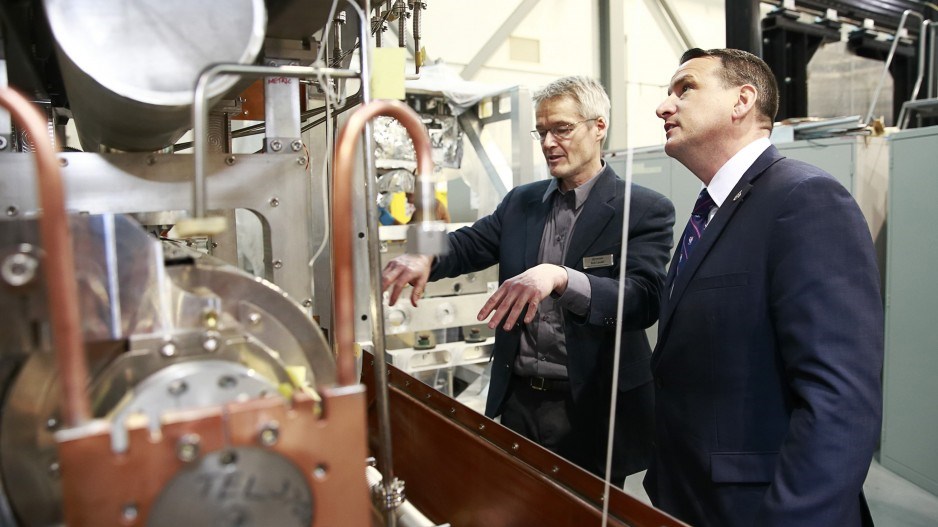Lia Merminga’s excitement is contagious, whether you possess an in-depth knowledge of accelerators, superconductors and particle beams – not to mention, understand the enormously positive impact that rare-isotope production could have on how we conduct scientific research, advance new technologies and diagnose and treat disease – or not.
As head of the accelerator division at TRIUMF – Canada’s national laboratory for particle and nuclear physics, and located at the University of British Columbia – Merminga is positively buzzing about her team’s latest success: a brand-new, advanced rare-isotope laboratory called ARIEL that officially achieved its first accelerated beam milestone on September 30, 2014.
“ARIEL, an acronym for Advanced Rare IsotopE Laboratory, includes a state-of-the-art electron linear accelerator – an e-linac, which is a Canada Foundation for Innovation-funded project led by the University of Victoria,” she explained. “It’s a true showcase of made-in-B.C. accelerator technology that’s set to become one of the most sophisticated rare-isotope facilities in the world.”
The successful completion of the project is, in truth, the consequence of a collaboration between TRIUMF, Canadian industry and 13 universities – a $62.9 million endeavour that was jointly funded by the B.C. and federal governments, with contributions from TRIUMF as well as partners in India and the United States.
“ARIEL will in effect triple TRIUMF’s capabilities for producing beams of rare isotopes and will expand the range of isotopes produced,” Merminga explained. “These isotopes are used to study the nature of stars, where the elements come from and how complex patterns arise from relatively simple building blocks. The implications [on other areas of science] are huge.”
Here’s how it works: the e-linac, located on the lower floors of the ARIEL building (an award-winning structure in its own right, built to LEED gold standards and bursting with novel environmental features), produces a beam of electrons travelling near light speed. A tunnel connects the accelerator to the isotope-production area, where the electrons are directed on targets made of beryllium, tantalum, etc. The resulting isotopes are extracted and sent to experimental areas in non-stop “streams” of exotic nuclei.
“As opposed to only having one beam that hits the target to produce isotopes that are currently feeding 18 different experiments, ARIEL will add two more rare-isotope beams, increasing our productivity and the quality of the science, allowing us to do more – and more long-term – experiments that we currently aren’t able to,” Merminga said.
From a human health perspective, ARIEL’s capacity to produce medical isotopes holds great promises to treat diseases, like certain types of cancer.
“For accelerator physicists like myself it’s an exciting project, of course, because we’ll be making advances and we’ll be contributing to the advancement of the field in its own right,” she said. “For our nuclear physicists and our nuclear medicine researchers, they’ll be able to do science with this machine; for our engineers and technicians it means steady employment and interesting work, for our industrial partners it means expanded business opportunities. So, it means different things to many people.”
Executed in line with TRIUMF’s commitment to the development of new technologies that have social and economic relevance, ARIEL is also set to be a boon for Canada’s tech sector. For instance, the five superconducting radio-frequency (SRF) cavities located along ARIEL’s beamline, which accelerate the electrons to nearly light speed, are engineered by PAVAC Industries in Richmond, B.C., in collaboration with TRIUMF.
“Designing and fabricating an SRF cavity is no simple feat,” said Robert Laxdal, deputy head of the accelerator division at TRIUMF. “The work between TRIUMF and PAVAC began in 2004 and resulted in the first production of superconducting cavities in Canada – in fact, PAVAC is one of a handful of companies in the world capable of producing SRF cavities. Using SRF technology for ARIEL gives TRIUMF and PAVAC the experience necessary to participate in global discussions and projects while training the next generation of leaders in this field, right here in British Columbia.”
One example of the international impact ARIEL is already making, thanks to its cutting-edge technical and scientific capabilities, comes from Kolkata, India, where the Variable Energy Cyclotron Centre (VECC) has teamed with TRIUMF to develop accelerator and isotope production technologies for each facility.
“Our scientific motivation is the same: to produce rare-isotope beams,” said VECC accelerator physicist Vaishali Naik, who is presently visiting TRIUMF, adding that her team is working with TRIUMF and PAVAC to produce a prototype of a cryomodule machine, which uses liquid nitrogen and helium to cool the SRF cavities to a point where they become superconductive. Once tested, TRIUMF will transfer the technology over to VECC, which has plans to build a particle accelerator of its own – smaller and lower-powered than ARIEL, but using B.C. tech components nonetheless.
As for TRIUMF’s ARIEL, the near-future plan for the project – besides continually advancing its scientific and technical capabilities and implications – is to expand the collaboration to 19 Canadian universities and five provincial governments, to complete ARIEL and begin its scientific utilization through the ARIEL-II project. ARIEL-II will forge new industry partnerships and create opportunities that will help train the next generation of scientists and engineers.
“It is breathtaking how quickly the e-linac came together … all driven by the hard work and superb technical expertise of dedicated scientists and students here and abroad,” said Merminga. “The outcomes could be a lot more than exciting – they could be a game changer. ARIEL opens up a whole new area of research for nuclear medicine, which we hope will lead to commercial applications, eventually, as well.”




